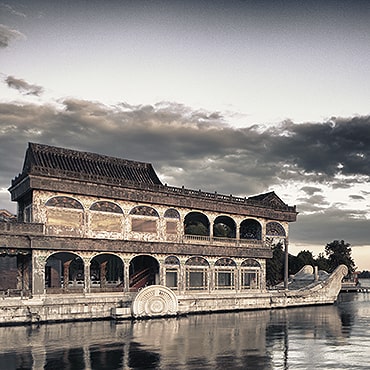
Yes, the previous 72/144 hours visa-free transit in China has been extended to 240 hours (10 days) since December 17, 2024. The visa-free transit in Beijing is the ideal way for travelers wanting time in this fabulous city and other permitted stay areas without having to go through a visa application process.
Created for the purpose of simplifying travel arrangements, 240 hours visa-free transit in Beijing means that so long as you meet the requirements (we cover these below in detail), you can enter and leave Beijing (or other listed open port) visa free.
Ready to travel visa-free to China’s capital? Let’s get you sorted with what you need to know.
> Learn more about China transit visas in this article.
What does 240-hour visa-free transit in Beijing mean?
Visa-free travel means exactly that: Travel without a visa.
The 240-hour visa-free transit policy was made available to international visitors to China in December 2024. Available at 60 different ports of entry in 24 provinces, the visa-free transit policy allows foreign visitors to enjoy the “cross-regional” travel. They can move freely across the 24 specified provincial-level regions during their 10-day stay in China.
Based on the List of Ports and Allowed Areas for 240-hour Visa-Free Transit, we add the main cities and popular destinations for a clearer understanding.
| Provinces (Autonomous Regions and Municipalities) | Eligible Ports | Permitted Stay Areas | Main Cities / Popular Destinations you may visit |
|---|---|---|---|
| BEIJING | Beijing Municipality | Great Wall, Forbidden City, Tiananmen Square, Temple of Heaven, Summer Place, Hutongs | |
| TIANJIN | Tianjin Municipality | Tianjin Eye (Ferris wheel), Ancient Culture Street, Tianjin Museum, Five Great Avenues | |
| HEBEI | Hebei Province | Shijiazhuang, Qinhuangdao, Chengde, Zhangjiakou (Jinshanling Great Wall, Chengde Mountain Resort, Shanhai Pass, Beidaihe, Zhangbei Grassland, Wanlong Ski Resort) | |
| LIAONING | Liaoning Province | Shenyang, Dalian, Benxi, Dandong Anshan (Mukden Palace, Dalian Xinghai Park, Anshan Jade Buddha Palace) | |
| SHANGHAI | Shanghai Municipality | The Bund, Yuyuan Garden, Shanghai Museum, Shanghai Tower, Yu Garden Bazaar, Jade Buddha Temple, Shanghai Science and Technology Museum, Zhujiajiao Ancient Water Town, Shanghai Disneyland Park | |
| JIANGSU | Jiangsu Province | Nanjing, Suzhou, Wuxi, Yangzhou, Lianyungang, Xuzhou, Nantong, Zhenjiang (Purple Mountain, Sun Yat-sen Mausoleum, Ming dynasty city wall and gates, Classical Gardens of Suzhou, Zhouzhuang, Yangzhou Slender West Lake) | |
| ZHEJIANG | Zhejiang Province | Hangzhou, Ningbo, Wenzhou, Shaoxing, Yiwu, Zhoushan (West Lake, Lingyin Temple, | |
| ANHUI | Anhui Province | Hefei, Huangshan, Wuhu, Anqing (Mount Huangshan, Tunxi, Xidi, Hongcun, Jiuhua Mountain) | |
| FUJIAN | Fujian Province | Fuzhou, Xiamen, Quanzhou, Zhangzhou (Gulangyu Island,Fujian Tulou Cluster, South Putuo Temple, Danxia Landform in Taining, Wuyi Mountains) | |
| SHANDONG | Shangdong Province | Jinan, Qingdao, Yantai, Weihai, Qufu, Tai’an, Weifang (Temple and Cemetery of Confucius in Qufu, Mount Tai, Baotu Spring, Daming Lake, Laoshan Mountain, Penglai Pavilion) | |
| HENAN | Henan Province | Zhengzhou, Luoyang, Kaifeng, Anyang (Longmen Grottoes, Shaolin Temple, Mount Song, White Horse Temple, Yinxu, Yuntai Mountain) | |
| HUBEI | Hubei Province | Wuhan, Yichang, Jingmen, Shiyan (Three Gorges of the Yangtze, Shennongjia, Yellow Crane Tower, Mount Wudang) | |
| HUNAN | Hunan Province | Changsha, Hengyang, Zhuzhou, Yueyang, Zhangjiajie (Wulingyuan, Zhangjiajie National Forest Park, Yueyang Tower, Fenghuang ancient town, Mawangdui) | |
| GUANGDONG | Guangdong Province (Exits available at all open ports across the province) | Guangzhou, Shenzhen, Zhuhai, Shantou, Foshan, Dongguan, Zhongshan, Chaozhou (Chen Clan Ancestral Hall, Shamian Island, Danxia Mountain, Window of the World) | |
| HAINAN | Hainan Province | Haikou, Sanya, Yalongwan, Wenchang, Qionghai (Yalong Bay, Nanshan Temple, Tianya Haijiao, Luhuitou Park, Wuzhizhou Coral Island) | |
| CHONGQING | Chongqing Municipality | Three Gorges of Yangtze River, Ciqikou, Hongyadong, Fengdu Ghost City, Baiheliang Underwater Museum, Dazu Rock Carvings | |
| GUIZHOU | Guizhou Province | Guiyang, Zunyi, Anshun, Liupanshui, Kali (Huangguoshu Waterfall, Mount Fanjing, Kaili Miao Villages, Zhenyuan Ancient Town, Libo Xiaoqikong Scenic Area) | |
| SHAANXI | Shaanxi Province | Xi’an, Xianyang, Baoji, Hanzhong, Yan’an (Terracotta Army, Xi’an City Wall, Giant Wild Goose Pagoda, Mount Hua, Famen Temple, Hukou Waterfall, Mausoleum of the Yellow Emperor) | |
| SHANXI | Taiyuan City, Datong City | Taiyuan (Shanxi Museum, Twin Pagoda Temple, Jinci Tempel, Tianlongshan Grottoes) Datong (Yungang Grottoes, Hanging Monastery, Shanhua Temple, Huayan Monastery) | |
| HEILONGJIANG | Harbin City | Harbin Ice and Snow World, Central Street, Saint Sophia Cathedral, Sun Island | |
| JIANGXI | Nanchang City, Jingdezhen City | Nanchang (Pavilion of Prince Teng, Bayi Square, Bada Shanren Memorial Hall, Qiushui Square) Jingdezhen (China Ceramic Museum, Jingdezhen Ancient Kilns and Folk Customs Museum) | |
| GUANGXI | 11 cities – Nanning, Liuzhou, Guilin, Wuzhou, Beihai, Fangchenggang, Qinzhou, Guigang, Yulin, Hezhou, Hechi, Laibin | Nanning (Guangxi Museum, Mount Qingxiu, People’s Park, Yangmei Ancient Town) Guilin (Li River, Reed Flute Cave, Elephant Trunk Hill, Seven Star Park) | |
| SICHUAN | 11 cities — Chengdu, Zigong, Luzhou, Deyang, Suining, Neijiang, Leshan, Yibin, Ya’an, Meishan, Ziyang | Chengdu (Chengdu Research Base of Giant Panda, Kuan Alley and Zhai Alley, Jinli Street, Wenshu Yuan Monastery, Wuhou Shrine, Mount Qingcheng, Dujiangyan) Leshan (Mount Emei, Leshan Giant Buddha) | |
| YUNNAN | 9 cities – Kunming, Yuxi, Chuxiong, Honghe, Wenshan, Pu’er, Xishuangbanna, Dali, Lijiang | Kunming (Stone Forest, Yuantong Tempel) Dali (Erhai Lake, Chongsheg Temple, Dali Ancient Town) Lijiang (Old Town of Lijiang, Shuhe Ancient Town, Jade Dragon Snow Mountain) |
Comparing with the previous “visa-free transit zone”, the expansion of “permitted stay areas” provides more freedom and options to the travelers, which means they can enjoy a China tour en route to their next destination country or region. For example, they can take a 8-Day Shanghai, Xi’an and Beijing tour to explore China’s ancient and modern capitals, or a 7-Day Shanghai and Yangtze River Cruise tour to be amazed by the breathtaking gorges and stunning mountain scenery.
Okay, so that’s all great, but how do you know if your country is on the list of those eligible for visa-free travel in China? Relax, we have you covered. We’ve already put that list together.
The good news is that the 240-hour visa-free transit policy applies to 54 countries (check out the list below).
| 40 European countries | Austria, Belgium, Czech Republic, Denmark, Estonia, Finland, France, Germany, Greece, Hungary, Iceland, Italy, Latvia, Lithuania, Luxembourg, Malta, Netherlands, Poland, Portugal, Slovakia, Slovenia, Spain, Sweden, Switzerland, Monaco, Russia, United Kingdom, Ireland, Cyprus, Bulgaria, Romania, Ukraine, Serbia, Croatia, Bosnia and Herzegovina, Montenegro, North Macedonia, Albania, Belarus, Norway |
| 6 countries in North and South America | United States of America, Canada, Mexico, Brazil, Argentina, Chile |
| 2 Oceania countries | Australia, New Zealand |
| 6 Asian countries | Japan, South Korea, Singapore, Brunei, United Arab Emirates, Qatar |
If you’ve spotted your country within the list, then it’s time to step through other requirements to meet the visa-free transit policy.
To qualify for a 240-hour visa-exemption transit, here’s what you need:
- A valid passport with at least 6 months validity and required visas for destination countries (if relevant)
- Your ticket for travel beyond China with a confirmed date and seat, indicating departure within the 240-hour window. The ticket must also show your destination before arrival in China, including any stopovers outside China (required as evidence of a third country). For transit purposes, Hong Kong and Macau are considered third territories. Be aware that your departure city and the destination city must be in different countries or regions.
- To smooth the process on arrival in China, let the airline check-in staff know you will need a visa-free transit. They will advise customs at the related Chinese airport custom of your request before landing.
- Prior to disembarking from the plane, you will complete the Arrival Card for Temporary Entry Foreigners.
- Once you have disembarked from the plane, visit the relevant customs counter to obtain approval for your 240-hour visa-free transit and have your passport stamped with a “Temporary Entry Permit”.
And that’s it. Who knew visiting Beijing could be so easy?
Still not sure whether the 240-hour visa-free transit is right for you?

There’s no doubt international travel comes with restrictions and it always pays to be doubly sure that you’re meeting all the entry requirements when visiting another country. If you’re still unsure as to whether you qualify for the 240-hour visa-free transit in Beijing, run through the list of specific exclusions list right here:
- Those who are inadmissible to China in accordance with relevant laws and administrative regulations
- Those whose international travel documents are valid for less than 3 months at the time of application, or those who possess international travel documents containing refusal stamps affixed by Chinese visa-issuing authorities;
- Those who have records of illegal entry or exit, illegal stay or residence, or illegal employment in China in the past 5 years;
- Those who have seriously violated the regulation of registering their addresses for temporary residence in China with the public security bureaus in the past 2 years.
In addition, foreign crew members aboard international sailing vessels and their accompanying family members are not eligible for this policy.*
Learn more here.
Are there any restrictions to the 240-hour visa-free transit policy?

This is a great question – and yes, there are some restrictions.
First, the policy applies for 240 hours of visa-free transit, rather than simply visa-free entry. This means you must transit to a third country or region, not simply return to your country of origin.
In the table below, you’ll find examples that help clear up the confusion.
| Travel route | 240-hour visa-free transit in Beijing |
| Australia – Beijing – United Kingdom | ✓ |
| Australia – Beijing – Australia | X |
| Australia – Beijing – Singapore^ | ✓ |
| Australia – Singapore^ – Beijing – Australia | ✓ |
^ Note that Singapore is an example only. Substitute any other relevant destination, for example, Hong Kong or Kuala Lumpur in your travel itinerary.
Your time starts now!

How are the 240 hours in Beijing calculated? Of course, every minute on your 240-hour visa-free transit counts, so you’d better be clear on exactly how your time on the ground will be calculated.
Here’s what you need to know:
The duration of your stay in Beijing will begin from 00:00 o’clock the following day after entry at Beijing International Airport, or Beijing Daxing International Airport. From 00:00 o’clock the following day after entry you are permitted to take cross-province travel within the allowed areas in 24 provinces (autonomous regions and municipalities) for up to ten days.
If due to unforeseen circumstances you’re unable to depart on time, such as flight cancellation or requirement for immediate medical treatment, you will need to apply for the relevant permit at the corresponding provincial or municipal exit and entry administrative bureau.
Other important details to know about the Beijing 240-hour transit-visa

Here are some other important details to know if you’re after a 240-hour transit-visa for Beijing.
Arrive in Beijing. Leave from another city
As we said earlier, the 240-hour visa-free transit policy has further expanded the allowed areas for visa-free transit travelers. The “permitted stay areas” cover 24 specified provincial-level regions (18 entire province and 36 cities in 6 provinces) that means you can have the “cross province” travel. During your 10-day stay in China, you can explore Beijing and its neighboring provinces and cities, or other destinations listed in the above table.
- As China’s capital, Beijing is home to countless treasures of Chinese culture and history. The city of Langfang, in the east-central part of Hebei, is located en route to Tianjin (in Hebei), effectively making it a corridor between the two locations.
- Tianjin borders Hebei Province and Beijing.
- Shijiazhuang is the capital of Hebei Province and Baoding is located about halfway between Shijiazhuang and Beijing.
With a well-designed private tour, you can expect to enjoy the very best of Beijing, while also visiting other carefully selected destinations within the “permitted stay areas” if you’re traveling 240-hours visa-free.
An important bonus of the transit-visa is that you can arrive in one city and leave from another in the “allowed areas”. That means you can arrive in Beijing, apply for the 240-hour transit-visa, and then depart China from Shanghai or Guangzhou, or any of the other ports listed above. Remember, if visitors plan to book and purchase their air ticket to a third country as the next destination after they enter China, they cannot apply for a 240-hour visa-free transit on arrival in China.
How to follow the rules for visa-free transit in Beijing
Now we might be stating the obvious, but for completeness, we’re just saying here that during your visa-exemption transit, you must abide by all Chinese laws and regulations. Specifically, what this means is you must:
- Cannot leave the permitted area of stay or overstay the visa-exemption period
- Are required to register where you are staying with the local public security bureaus or foreigner service stations, or those who are providing accommodation can complete the registration on their behalf in the first 24 hours of entry. If you’re staying at a hotel, the hotel is obliged to register where you are staying for you.
Be aware that in the case of force majeure which necessitates a longer period of stay than 240 hours within the visa exemption area, you must lodge an application to the exit and entry administration department of a public security bureau for corresponding stay or residence documents. And if you’re thinking you might overstay your visit, travel beyond the permitted stay area, or depart from a port you’re not supposed to, then think again. This isn’t looked on favorably, so it’s best to adhere to the requirements of the visa.
What can I see on a 240-hour visa-free holiday in Beijing?

Already planning your 240-hour visa-free holiday? Here’s our curated list of destinations and sites in Beijing, Tianjin and Hebei province to visit if you have ten days. And of course, you can travel further to other cities listed in “permitted stay areas” for more exploration and discovery in China.
| City | Why visit | What to see |
|---|---|---|
| Beijing | China’s capital. Let’s face it, Beijing is a must-see for any traveler to China. | Great Wall, Forbidden City, Tian An Men Square, Temple of Heaven, Summer Palace, Yonghe Temple, Confucius Temple and Imperial College Museum, Hutongs |
| Tianjin | A port city that borders Hebei Province and Beijing. Located about 26 nautical miles inland from the Bohai Gulf off the Yellow Sea on China’s east coast. Largest open city on northern China’s coastline. | Tianjin Eye (Ferris wheel), Huangyaguan Great Wall, Ancient Culture Street, Tianjin Museum, Five Great Avenues, Tianjin Water Park, Nanshi Food Street, the Porcelain House, Mount Pan |
| Shijiazhuang | The capital city of Hebei Province. Visit if you’re keen to see the site of a memorable Crouching Tiger, Hidden Dragon’s at Cangyan Mountain. | Cangyan Mountain, Zhaozhou Bridge, Longxing Temple, Kaiyuan Temple, Hebei Provincial Museum |
| Chengde | Marvel at the Qing dynasty’s imperial summer residence among other incredible historical and cultural sites. | Mountain Resort, Potala Palace (the amazing Putuo Zongcheng Temple), Eight Outer Temples, Puning Temple, Qingshui Mountain (Sledgehammer Peak) |
| Qinhuangdao | The seaport city named after Emperor Qin Shi Huang, famous for being the first emperor to unite China. | Shanhaiguan (No.1 Pass of Great Wall), Beidaihe (a popular coastal resort town), Qinhuangdao Wildlife Park, Laolongtou (also referred to as Old Dragon’s Head, where the Great Wall meets the ocean). |
| Zhangjiakou | Referred to as the Northern Gate of Beijing, a host city of the 2022 Winter Olympics. | Dajing Gate (a pass of the Great Wall), Zhangbei Grassland, ski resorts, Nuanquan Ancient Town (the traditional folk art of Dashuhua, throwing molten iron to create sparks as dazzling fireworks) |
What’s the process for obtaining the 240-hour visa-free transit?

If you’re ready to line up for 240-hour visa-free transit in Beijing, here’s what you need to do.
Step 1
At check in for your travel to Beijing or any other city covered by the 240-hour visa-free transit allowed area, show your valid international travel document and onward tickets (air/vessel/train) to a third country (region) with confirmed date and seat.
The carrier will submit your information to the corresponding immigration inspection station in China for examination. Your application will be processed on arrival once all details have been confirmed.
Step 2
You will find the 240-hour visa-free transit counter at the immigration inspection and apply for the stay permit if you arrive at Beijing International Airport or Beijing Daxing International Airport.
Step 3
On arrival, you will need to provide the immigration officer with your valid international travel document and onward plane, vessel or train ticket to a third country (region) with a confirmed date and seat within 240 hours upon arrival. You will also need to show completed arrival/departure cards filled out in detail. Keep in mind that you should be ready to answer questions raised by immigration officers. A Temporary Entry Permit sticker will be placed on a page of your passport.
Good to know: There is NO charge for a temporary entry permit at the immigration inspection stations.
A final word on the 240-hour visa-free transit in Beijing
Visa free travel in Beijing using the 240-hour visa-free transit is ideal for travelers who have a stopover or transit in Beijing.
Even if you take a spontaneous trip to Beijing and don’t have a visa organized in advance, and you intend traveling on to another destination (that is not your country of origin), it really does offer incredible flexibility. The real bonus is you’re not limited to staying in Beijing, but can travel more widely to other destinations within the “permitted stay areas” in 24 provinces. With the opportunity to take in the sights, sounds, flavors, culture, and history of China, you really can design a travel adventure you’ll love and always remember.
Ready to discover this very special part of China? Let us take you there with one of our private and fully guided day tours, multi-day tour packages, and custom tours. Enquire today and start exploring.




 Beautiful China!
Beautiful China!





